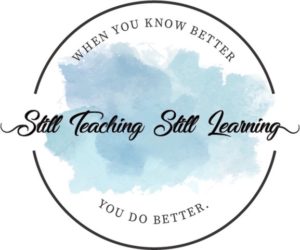
Have you ever looked at your ever-growing to-do list and thought, “There ain’t no way all of this can get done”? Yeah, me too.
Overwhelm starts to take over and I find myself almost paralyzed and unable to get anything done. Or I hop from unimportant task to unimportant task and the bigger, more important tasks don’t get done. Sound familiar?



Overwhelm can hit us at any time during the year. Right now it is hitting me because of all the teaching tasks I need to do, but also because of all the holiday tasks I need to do.
We may not be able to stop the wave of overwhelm, but we can learn how to take charge of it and get ourselves back to a feeling of being calm and of being in control.



Here are 12 strategies I rely on when the overwhelm hits.
1 – First, get it all down on paper. There are a couple of ways to do this.
One way is to list everything in one gigantic list. I tend to use a journal for this because it has lots of paper and I can always rip out pages if needed.
Another way is to write each separate task on a post-it note.



Just getting it all out of your head and onto paper is a huge stress relief. Now you don’t have to constantly obsess about all the things you need to do because you’re afraid you’ll forget something. It’s all written down and you will get to it when you get to it.



2 – Next, I like to categorize the tasks by category. What are work tasks, home tasks, personal tasks, family tasks, etc.? You can label your tasks by letters (like W for work, H for home, etc., OR you can use abbreviations.
If you’re using post-it notes, you can move the notes around to different pages labeled with your category names.



3 – Now that we’ve listed ALL the things and put them into categories, it’s time to prioritize the tasks.
I like to use a different color pen or a highlighter for this part. I use a simple ABCDE system.
A = most important to do ASAP.
B = important to do soon.
C = could be postponed if necessary.
D = this is a task to delegate.
E = this task needs to be eliminated. This could be because the task is just not important at all or just not feasible for this time in your life.



4 – Now, put the lists away and do some cleaning or decluttering of your space. Somehow cleaning up the space around me makes me feel more in control, even with a gigantic list of tasks waiting for me. Plus, there is something about taking a break from looking at the list that helps bring some more clarity around what is most important to prioritize.



5 – Back to that list (or sticky notes). Take a look at your A tasks and put those in order of what has to be done first, next, and so on.
Do the same with your B tasks. Leave the C tasks alone for now. (I like to put them on a “To Do, but Not Today” list.)
For the D tasks, indicate (with a different-colored pen!) who will be the lucky person to get the delegated task. 🙂 Then, for the E tasks – you get to cross them out (or throw away the sticky note).



6 – With your A tasks prioritized, take a look at the tasks that are bigger projects. Try to break them down into small, do-able parts. You know the saying about how you can eat an elephant one bite at a time? Take those tasks and list all the little things you need to do to actually complete that task.
For example: if one of my tasks is “decorate indoors for Christmas,” think about all the little tasks that need to be done in order to complete that big task.
Some of my mine are: put away fall decor, pull Christmas decor boxes out of the attic, store the boxes in the hall (or wherever), decorate the entryway, decorate the living room, decorate the dining room, etc.



I know what you’re thinking – yes, this sounds like a lot of work. But here’s the thing: if you break the tasks down into small, do-able parts, you will get the task done much more quickly and with much less overwhelm.
You can complete one small task towards your bigger task and feel like you actually accomplished something. That gives you motivation and energy to get back to the task the next time you work on it.
7 – Now it’s time to schedule those prioritized tasks. When will you actually work on them? There are a couple of ways you could plan for what to do.
Back to my example of decorating indoors for Christmas. I could write down one or two of those bite-sized tasks and what time I plan to work on them (5:30 – 6:00 p.m., after dinner, etc.) OR I could plan to do Christmas tasks for 15 minutes at 5:00 p.m. If I plan for that, I actually set a timer and keep doing small tasks until the timer goes off.



Somehow getting a few things done every day helps you progress toward a larger goal and gives you motivation and energy to keep going the next day (or the next time you have a little time to work). Even five minutes is enough time to get back on track with getting things done.
As you gradually check more and more tasks off your list, you will feel more energy and motivation around getting things done.



8 – Focus on three tasks at a time. Get those three tasks done (or part of the task, if you’re doing the elephant-eating thing). When those are done, then look at the next three tasks to do. And if you only get three tasks done in a day – and if those were your prioritized tasks – count that day as a win.



9 – When you start on your first task, just focus on that task. Try to eliminate distractions. Turn off your phone notifications. Shut your door. Do whatever you need to do to get the task done. Then take a break before starting on the next task! (If you do get distracted – or interrupted – just deal with whatever came up and then get back to your focus task.



10 – Add some joy to your tasks. What can you do at the same time that will make the task more fun to do? Listen to a favorite playlist, podcast, or audiobook? Watch a movie or TV show while you’re doing something that doesn’t require as much concentration? Find some way to add enjoyment to your tasks.



11 – When you finish your tasks for the day, go ahead and make your list for the next day.



12 – Remember that you do not have to be productive every minute of every day! Taking a break to get some rest is important too. (I have an entire post about different kinds of rest.) One challenge with overwhelm is that we feel drained of energy and it can be difficult to focus. If you need to rest, do not feel guilty!



To review:
1 – make a gigantic brain dump list of all the things.
2 – categorize the tasks by category (home, work, personal, family, holiday, etc.)
3 – prioritize the tasks in each category
4 – clean or declutter your space
5 – put your prioritized tasks in order of when you will do them (including which tasks you will delegate and which you will eliminate altogether for now)
6 – break your big tasks down into small, bite-size bits that can be done in small chunks of time
7 – schedule the tasks. When will you work on the first things on your list?
8 – choose three tasks to start. Just three! (You can always add more, but choose three to start.)
9 – when it’s work time, focus!
10 – add something enjoyable to your work time!
11 – when you finish your tasks for the day, make your list for the next day
12 – it’s okay to take a break and rest!
Let me know how these tips work for you!
Need some encouragement on how to manage your teaching time so it doesn’t take over your personal life? Join our Sustainable Teaching Membership on Patreon!
